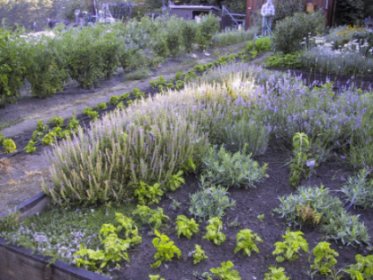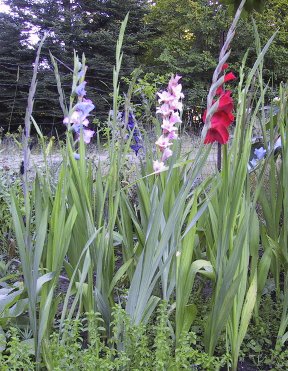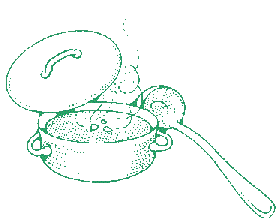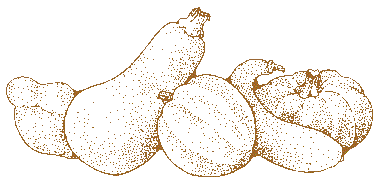
The Compost Heap
News, Views, and Features from the Posh Squash Garden
The Sea Ranch, California
Harvest 2002, Issue #6

Editor’s note: This issue of The Compost Heap will be the last until next year. However, we will maintain the Website with timely information. We thought it fitting to stretch out our report of the Steering Committee into a kind of summing-up and look ahead, a wind-up of the season.

The Steering Committee met Friday, October 25, 2002, 1:00-3:00, at the Del Mar Center. Present were Tom Warnock, Mary Austin, Ken Holmes, Iris Borg, Dianne Rasmussen, Jim Grenwelge, Ben Klagenberg, John Horn and your scribe, Chester Case. The Committee received, with thanks, a written communication from Laura Franklin articulating ideas and concerns of a group of Wednesday Gardeners.
Tom summed it up to the nodding of heads in assent, “We learned a lot this year.” 'Round the table, Committee members spoke of what we learned: watering, the timing and sequence of seeds -- germination-planting-harvest, group decision-making on behalf of the Garden by the Steering Committee, roles of the Day Leaders, effecting capital improvements, communication among Gardeners and the Steering Committee. We learned more about what will grow and what won’t and, as if we didn't already know, about how the Garden will surprise us, as it did with the avalanche of tomatoes -- but not all of the best variety for the Garden.
The Committee also reviewed accomplishments of this season. A long-time Gardener exclaimed on the beauty of the Garden this year, an observation echoed by all. Beyond basic gardening (several abundant crops and a couple of noble failures, too), maintenance and management, we rebuilt the shed, built raised beds for herbs and flowers, enjoyed splendid germination in the greenhouse, relocated the tent greenhouse, expanded the compost facilities, initiated the newsletter and website. The Committee also continued discussions and planning for the future of the Garden site.
Befitting the transition from the Fall growing season to winter, and in anticipation of next season, the Committee engaged in a busy, lengthy meeting. Here are highlights of the meeting:
Treasurer Iris reported on Garden financials. A good balance of $2919 is on hand, but she noted that several sizable bills for water and the rototiller are yet to come in. Presently, annual dues are $75. No need was seen to raise dues.
Tom updated the situation with the Garden site. Essentially, no new news, as Kelley Mason is just now returning to work (return? who says a new baby isn't work?). Ben updated the rototiller situation (see story elsewhere).
Jim Grenwelge reviewed plans, preparations, decorations and program for the annual Harvest Dinner. He displayed a very good-looking poster created by his wife Susan. Day Leaders will make sure all Gardeners have the who, what, where and when details, especially what type of dish is assigned to each day. Nominations for the Gardener of the Year and the Peter Farmer Award were made. Recipients will be honored at the dinner.
The present system of day crew watering has its flaws, but it works well enough to continue for another year, then re-evaluate. The quality and consistency of watering continues to be a problem -- in a word, too little or too much. In the case of the herbs and flowers, of watering differentially depending on the plant. Weekend watering will need to be scheduled. (See Help Wanted story).
The pros and cons of the newspaper-and-woodchips mulching project were discussed. On balance, the Committee decided, the potential benefits justify continuing the project but with careful monitoring for adverse effects.
The season of winter gardening is upon us. Some beds need to be retired and mulched, and others prepared for winter plantings of garlic, shallots, green onions, some lettuces and other greens. Dianne asked if she and a group of Gardeners could use the greenhouse to grow lettuce. The Committee said more power to you, but be aware that we will need to get the greenhouse cranking for Spring planting in a timely way. Although the Garden pretty much rests for the winter, there are things to do and Gardeners are encouraged to come on up on clement days to work and see if anything is ready to pick. (See Help Wanted).
Ken Holmes wondered about the use of kelp in the Garden as a soil amendment via composting. Kelp collects the trace elements of the ocean. A lot of work, but worth a try. Further inquiry and clearances will be made.
Several key positions in the scheme of things need to be filled, as the incumbents, after long and faithful service, wish to relinquish their duties. Jer Skibbins in the Greenhouse, Sal Skibbins ordering and buying seeds, Jeanne Holmes coordinating the watering schedule have earned the thanks of the Garden for their work. Replacement, anyone? (see Help Wanted).
The Committee pondered ways to improve operations and communications among the Gardeners, especially with regard to “the Posh Squash Way” of doing essential tasks like watering, planting, harvesting, bed preparation. Also, how to keep the selection of crops in tune with the desires of the Gardeners. Sharing information will be facilitated by consolidating, in a central place, reports, evaluations and histories of what has been planted, how, where, and with what results. The idea is to keep a record of what does and doesn’t grow. Mary, Sal and John, this year’s planning troika, will meet with Diane and a group of Wednesday Gardeners to design and compile this reference source.
The Steering Committee also discussed how to maintain the crucial calendaring, sequencing and synchronization of the process of selecting and getting seeds, greenhouse germination and planting, bed preparation, and replanting as the season progresses, especially with regard to the role the Committee needs to assume in coordinating and controlling.
In anticipation of the February, 2002 Organizational Meeting, the Committee contemplated ways to make it an occasion for maximally effective communication and interaction among Gardeners, including expanding the usual program into a longer session.
The Newsletter Group was congratulated on the production of six fine issues as it prepares to wind up this season.
For further details or copies of anything, ask your Day Leader or Tom or Mary, or visit the Posh Squash Website.

Time to think ahead. Bask in the appreciation of your fellow Gardeners, learn new stuff, keep busy, participate in the whole big scheme of things. Sign-ups at the February 2003 Organizational Meeting, but you can step forward now:
Greenhouse workers:
A great way to apply your plant-nurturing skills or to learn new ones. Experienced green thumbs will share their knowledge. At a minimum, the Greenhouse needs one person for each day.
Watering Schedule Coordinator:
Since watering will be done Monday-Friday by day crews under Day Leader supervision, the essential work of this position is on the weekends. Gardeners will sign up for weekends at the Organizational meeting, and the Coordinator will compile the calendar.
Compost workers:
Now that the facilities have been expanded, we can try to increase production. Needed for each day Monday-Friday is a person or two to monitor the Bins and Heaps and do some chopping, tossing and turning. Partner up with the microorganisms, worms and bugs to make Garbage into Garden Gold.
Archivist(s):
The Giant Posh Squash Scrapbook needs to be brought up to date. Assuage your archival itch by collating and installing Garden photos, flyers, newsletter, other memorabilia in the Garden Archive.

Work continues in the winter for which work parties will be assembled and fall to. Keep your eye on the Website for when and where. Here are some of the opportunities: plant garlic, prune raspberries, cleanup, take down tent greenhouse, kelp gathering at the shore and transport to the Garden, more... Check the Website for the latest.
Ben says we can expect Big Red, the Troy-Bilt rototiller, back on the job late in November. We hope. It’s an old machine, and parts have not been available. The drive shaft had to be remanufactured. At a cost of about $750, Big Red will roar back into service with an overhauled transmission, a new clutch, a reverse gear that works, and new blades. Good as new, only a comparable new machine would cost over twice that amount.

We'll be GLAD to see Big Red!
![]()
Tongues the last nectar
On sunset's palette
Garden Haiku by Gerry Wilson
Common fennel (foeniculum vulgare) is everywhere. It grows wild and invasive along roadsides and in vacant lots, as well as in gardens where the gardener may regret planting it. The tall, lacy stalked plant, super for flavoring and garnish, is better known than the underappreciated bulb fennel (finocchio), which deserves top kitchen billing. It has star qualities! Like a really good actor, it is versatile yet distinctive, subtle, strange, yet familiar: it reminds you of something...licorice, friendly folk medicines...yet has its own character.
If you are not already a bulb fennel fan, this is a good year to get acquainted. The Garden is graced by a fine stand of 108 bulb fennel lifting their lacy tops in Bed 36 and 38. Thanks to the wire basket protection from the quail (who know a good thing), our bulb fennel is doing well and should be ready for picking late fall. Take fennel when the bulb is mature (and the green ribbon sez OK). To harvest, loosen the soil and pull the whole plant. Save leaves for garnish or flavor if you like.
Alice Waters applauds bulb fennel. In Chez Panisse Vegetables, she casts the crunchy bulb in a leading role in ten recipes. She presents it in a variety of roles: sliced, diced, shaved, grilled, braised, in broth and oven-baked dishes. Fennel plays well raw in salads. It plays well in tapenade, too.
What our family likes especially is Fennel Soup. What a deal. Pick some fennel on a cold day, cook it up, hearty and hot with beans and pasta. Bravura performance! Here is a recipe Shirley Case adapted from Judith Barrett's low-fat recipe.
(six servings)
1 medium fresh fennel bulb, cut into cubes
1 medium onion, cut in 8 pieces
2 medium carrots, cut into 2-inch pieces
1 rib celery, trimmed and cut into 1-inch pieces
1 large clove garlic, peeled
2 teaspoons olive oil
2 cups canned chopped tomatoes, with their juices
4 cups defatted chicken or vegetable broth, preferably homemade
1 cup cooked or canned (drained and rinsed) white beans such as Great Northern, navy or cannellini
1/2 cup short tube-shaped pasta, such as small sea shells or tubetti
2 tablespoons chopped fresh basil leaves
2 tablespoons chopped fresh parsley leaves
2 tablespoons freshly grated Parmigiano-Reggiano cheese (optional, add just before serving)
Combine the onion, carrots, celery, fennel and garlic in a food processor and process until the vegetables are finely chopped, about 15 seconds (or finely chop by hand).
Heat the oil in a heavy 4-quart saucepan over medium-high heat. Add the chopped vegetables and cook, stirring, until they begin to soften, 2 to 3 minutes. Stir in the tomatoes and broth and bring to a boil. Cover, reduce the heat to medium-low, and simmer for 20 to 30 minutes. Add the beans and pasta and cook, stirring frequently, until the pasta is tender but al dente, about 10 minutes. Season with salt and pepper to taste. Stir in the basil and parsley. Garnish with some of the cheese, if desired.
Nutritional facts per serving without the cheese: 138 calories, 2.5 g fat, 16% of calories from fat.
submitted by Shirley Case

This is from Ruth Reichl's Comfort Me With Apples, via a friend who comments "No, I don't think it would taste the same using low fat or soy cheese and soy milk..."
One pumpkin, about 4.5 pounds
A 14" baguette, cut into 1/4" slices, then toasted lightly
1/4 pound gruyere cheese, grated
1-3/4 cup half-and-half
2 large eggs
1-1/2 tsp kosher salt
1 tsp freshly ground black pepper
1/4 tsp nutmeg
Preheat the oven to 350 degrees. Carefully cut a 1-inch slice off the top of the pumpkin. Reserving the top, scoop out and discard the seeds and strings. Make 3 layers each of toast and cheese in the pumpkin cavity, alternating and ending with cheese. Whisk together the half-and-half, eggs, salt, pepper and nutmeg, and slowly pour the mixture into the pumpkin. Replace the top of the pumpkin and bake on a shallow baking pan in the middle of the oven til the pumpkin is tender, about 2 hours. Serve by scooping out the pumpkin flesh with the bread and cheese.
Serves (insert sardonic laugh here, says my friend) four.
submitted by Reva Basch

Photos by Reva Basch